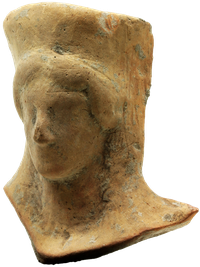Head with polos and veil (?)
Description: The head is adorned with a broad polos. The hair, parted above the forehead, forms two smooth arches, followed by a retraction at the temples, which is joined by two further arches above the ears. Wavy strands, which can hardly be distinguished from the falling veil (?), reach down to the shoulders.
A strong nose with broad wings defines the face, which gradually tapers over the smooth cheeks to the pointed chin. Full horizontal lips form the small closed mouth, separated from the chin by a shallow pit. The eyes are set wide apart, under moderately high orbitals and arched brows. Upper and lower eyelids cannot be separated. No bulge is visible on the eyeballs.
Commentary: The comparison with female statuettes shows[1] that T I-13 comes into consideration as the head of a standing or enthroned female figure approx. 25-27 cm tall, but the affiliation to a posed youth figure is also not completely excluded[2]. The determination of the sex ultimately remains open.
Specific Tarentine features are the broad polos and the wide distance between the eyes[3].
The roundish-oval shape of the face, a moderately high forehead and the framing of the face by hair arches[4], as well as relatively small eyes with flat eyeballs speak for a somewhat later period of origin with regard to inv. no. T I-12.
Determination: 3rd quarter of the 5th century BC, from Taranto.
 |
 |
 |
|---|
[1] H. Herdejürgen, Die Tarentinischen Terrakotten des 6. bis 4. Jahrhunderts v. Chr. im Antikenmuseum Basel (Basel 1971) 8. 77 pls. 27 a and 28 a.
[2] C. Iacobone, Le stipi votive di Taranto (Rom 1988) 65 pl. 53 b; E. Lippolis (ed.), Arte e artigianato in Magna Grecia (Neapel 1996) 199 f. no. 140.
[3] H. Herdejürgen ibid. 1971, 77 pl. 27 a; U. Hübinger – M. Menninger, Terrakotten der Westgriechen im Akademischen Kunstmuseum der Universität Bonn (Rahden/Westf. 2007) 90 f. fig. 7.
[4] Cf. M. Rubinich, Ceramica e coroplastica dalla Magna Grecia nella collezione de Brandis. Udine (Triest 2006) 207 no. 290.

